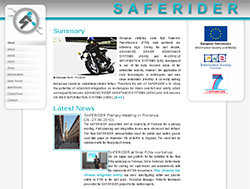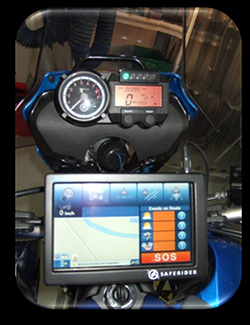 The BBC article – “Motorbikes ‘to get safe driving aids’”, (which Right To Ride EU reported on recently, MIRA Is Your Co-Pilot regarding the press release from MIRA a UK company), has had a reaction from FEMA (Federation of European Motorcyclists Associations), who were partners with MIRA in the SAFERIDER consortium.
The BBC article – “Motorbikes ‘to get safe driving aids’”, (which Right To Ride EU reported on recently, MIRA Is Your Co-Pilot regarding the press release from MIRA a UK company), has had a reaction from FEMA (Federation of European Motorcyclists Associations), who were partners with MIRA in the SAFERIDER consortium.
What the BBC report and the FEMA article failed to mention is that the very reason for our “No To Throttle Control” campaign was because of the development of the Force Feed back Throttle as well as the integration of warning functions by the SAFERIDER consortium, that would distract the rider.
The “No To Throttle Control” campaign by Right To Ride to have the Consortium withdraw the Force Feedback Throttle was successful. The Consortium agreed to withdraw the device because it failed to prove to be a worthwhile product (although the pressure from riders and organisations such as FIM, must have influenced their decision).
The warning devices were the brainchild of the SAFERIDER Consortium which put together a proposal to get funding from the EU Commission, basing their concepts on car technology. What they convinced the Commission was that they would be able to move this technology on to 2 wheeled vehicles. Unfortunately they did this without consulting expert riders.
When the project started, the then FEMA representative requested that the consortium carry out a Europe wide survey and consult a focus group of experienced trainers from across Europe, which they did, but the trainers in the focus group told them that they believed the ARAS (Advanced Rider Assistance Systems) would most likely be unsuccessful because of the distractions and confusion that they would cause.
The consensus of the focus group with regards to the OBIS (On Bike Information Systems) was more positive. They agreed that advice on traffic conditions, weather and so forth was useful, although it was pointed out to the representative of the Consortium that most of the systems they were developing in the project were already available or were being developed elsewhere.
 In the latest FEMA report it states that at the end of a lengthy engineering process in the Saferider project, “the main question riders are tempted to ask is. “Are these systems “roadproof”? Are they useful, reliable, practical – and above all, safe to use?” and quite correctly state that, “Anyone who has even ridden a motorcycle knows how critical these questions are.”
In the latest FEMA report it states that at the end of a lengthy engineering process in the Saferider project, “the main question riders are tempted to ask is. “Are these systems “roadproof”? Are they useful, reliable, practical – and above all, safe to use?” and quite correctly state that, “Anyone who has even ridden a motorcycle knows how critical these questions are.”
While we welcome the development of systems that aid riders, our view is that any device must be complimentary. It should never aim to remove the concentration of the rider or replace their ability to react and definitely never in a critical situation. The criticism of the ARAS devices is that they are active warning systems that will distract, by the very nature of the HMI (Human Machine Interface) warnings – e.g. vibration, lights etc
FEMA has pointed out that, “These products, seeing how they can affect a rider’s relation to the surrounding traffic, will need to undergo testing on a larger scale, in depth and in length, before they can be released to the market.”
FEMA reports that riders’ concerns, “featured prominently in the rider survey held at the beginning of the project, but these concerns have not been fully taken into account during the research and development process.”
The other interpretation of this comment is that in spite of carrying out the survey and a focus group of experts, it was too late, because the Consortium had already decided what they were going to develop. What they had hoped was that the survey respondents and trainers in the focus group would rubber stamp their concepts, when that didn’t happen they selected the results.
What the MIRA and FEMA press releases fail to consider, is whether these devices would actually make a difference in reducing casualties. The expert trainers were adamant that they would not achieve this result, in part because there would not be sufficient time for the warning systems to kick in and because the overload of information would be so great that the rider would lose concentration and be distracted.
The SAFERIDER project ended in November with the conclusion that the 5 million Euros spent was not sufficient because the devices need to be tested in real road conditions, therefore it appears that the Consortium will aim to ask for more funding.
 Indeed, FEMA has stated that “Unfortunately, as a breakthrough project, SAFERIDER could not run tests deep and wide enough to fully assess the systems’ effects on basic riding tasks. When performed, tests mainly involved simulators which do not fully reflect real-life conditions.” (well not really, because the bikes – not simulators – were tested at MIRA and Yamaha on test tracks).
Indeed, FEMA has stated that “Unfortunately, as a breakthrough project, SAFERIDER could not run tests deep and wide enough to fully assess the systems’ effects on basic riding tasks. When performed, tests mainly involved simulators which do not fully reflect real-life conditions.” (well not really, because the bikes – not simulators – were tested at MIRA and Yamaha on test tracks).
“Testing on real motorcycles has only been performed on a small scale, which does not allow for proper evaluation of the impact on behaviour, decision-making, awareness, distraction or comfort.” (This is surprising considering that a number of riders were invited to test the bikes at MIRA).
“With limited data on user perception, acceptance and willingness to buy (again this is interesting because part of the research was to conduct a market analysis including questions in the survey which asked over 4,000 motorcyclists how much they were willing to pay) it is hard to draw conclusions on whether these systems have a true potential in assisting riders. The doubts raised by riders and training experts would have to be dispelled – or confirmed – by real-life tests” (using more taxpayers’ money).
The FEMA press release concludes: ”SAFERIDER however, succeeded in creating an interest around intelligent transport technologies for two-wheelers, including recognition of the need to investigate the link between technology and the riding task. This, in itself, represents a positive step for motorcycling.”
Or in plain speak, the SAFERIDER project was promoted throughout the scientific community as an example of HMI systems. On the other hand, it created consternation for many individual riders such as ourselves, who were ignored when we tried to have a dialogue with the Consortium about our concerns regarding the systems.
FEMA Press Release – www.feme-online.eu
Another view from our friends at Back Roads Rider – Mira, Mira On The Wall……
Go onto any motorcycle web forum and riders are talking about this issue – most do not want these systems on their bikes!
SAFERIDER – www.saferider-eu.org
SAFERIDER – Presented by FEMA an opinion on – Riders’ Feedback And Views – pdf1.29mb – Click Here
MIRA wanted You In 2010
“MIRA need a broad spectrum of men and women, of all ages, with a full motorcycle licence.
The type of bike you own, the sort of riding you do and your level of experience does not matter.
You will try out products that are not yet on the market and you will be making an invaluable contribution to safety research that could benefit riders across Europe and beyond.
Where Are You Now? – What did you think of riding the kitted out bikes!”
e-mail – info@righttoride.eu


Speak Your Mind